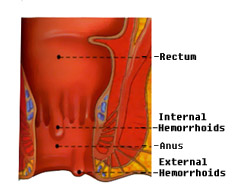Conventional procedures for hemorrhoids
If you are diagnosed as having hemorrhoids, a high-fiber diet combined with sitz baths and acetaminophen should reduce discomfort within two weeks. If symptoms persist, your doctor may recommend one of the following procedures. All except laser coagulation and surgery can be performed in your doctor's office.
Injection
An internal hemorrhoid can be injected with phenol in oil, quinine, and urea, or morrhuate sodium, which creates a scar and closes off the hemorrhoid. The injection hurts only a little, as any injection does. With a success rate of 90 percent, this is many physicians' first choice. Results are not permanent, however; repeat injections may be needed every two or three years.
Banding
Prolapsed hemorrhoids are often removed using rubber-band ligation. A special tool secures a tiny rubber band around the hemorrhoid, shutting off its blood supply almost instantly. Within a week, the hemorrhoid shrivels and falls off. This painless method is successful about 75 percent of the time.
Coagulation or cauterization
Using either an electric probe, a laser beam, or an infrared light, a tiny burn painlessly seals the end of the hemorrhoid, causing it to close off and shrink. This is most useful for prolapsed hemorrhoid.
Surgery (hemorrhoidectomy)
For internal hemorrhoids or really uncomfortable external hemorrhoids (such as thrombosed hemorrhoids that are too painful to live with), your physician may elect traditional surgery, called hemorrhoidectomy. In the hospital, under general anesthesia, the hemorrhoid is removed. After the operation, expect a week or so of bed rest, with analgesics prescribed for discomfort.
The success rate for hemorrhoid removal approaches 95 percent, but unless dietary and lifestyle changes are made, hemorrhoids may recur.
Before you take any further steps you should gather more information about the causes, diagnostic procedure, treatment and prevention of hemorrhoids.

